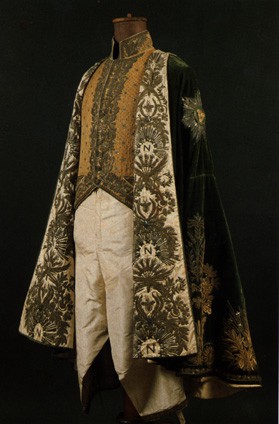Thomas Stibbert, originally from Norfolk (UK), emigrated to Italy after the fall of the First Empire and settled in Florence with his young Tuscan bride, Giulia Cafaggi. And it was their son, Frederick, who put together, and set up as a museum, the rich collection today known as the Museo Stibbert, dedicated to the history of costume and also arms and military equipment and uniforms.
Frederick Stibbert, a British citizen who was born in 1838 in Florence but educated in Cambridge, inherited the family taste for militaria – his grandfather had been Commander in Chief of the East India Company in Bengal and his father had fought with the Napoleonic armies in Egypt, Hanover in 1805, Copenhagen in 1807, and Spain in 1808. In Italy, Frederick joined Garibaldi's forces and was awarded a medal for bravery. On coming of age in 1859, Frederick found himself at the helm of a large inheritance, which he determined to increase by means of financial dealings in Italy and in the rest of Europe. A wily collector, Stibbert was interested in all to do with costume and uniforms. But he was not merely an English romantic who had chosen to live in an Italian paradise. He was an astute international financier who in his travels followed the European art markets for nearly 50 years as he amassed his collection, his life's work, a museum entirely devoted to the history of costume, from the Renaissance to the First Empire.
It was in the family villa, situated in the slopes above Florence, that Stibbert chose to install his museum. In 1879, he started construction work designed to extend and adapt the existing building to fit its new role – these continued right up to Frederick's death in 1906. Now perfectly restored, this building (called the Fabrica di Montughi holds today a magnificent collection of nearly 50,000 items. And the objects on show are put in settings which conform to Stibbert's own idea of how a museum should be arranged. In other words, the rooms are specially designed to create the right atmosphere, the items are presented in ensembles, some of the costumes are remade and arranged in semi-theatrical poses.
Thus the First Empire collections are exhibited in a special Empire room. Arms, such as combat and ceremonial swords, turkish sabres, and dragoon helmets, surround other more surprising items, such as the a decree for the modification of coats of arms of the city of Florence dated 1811 and signed by Napoleon. But the piece de resistance is the coronation costume worn by Napoleon in the Duomo in Milan in 1805. It is green (in honour of Italy) and covered in Napoleonic symbolism: notably, embroidered palms, laurels and bees, stars surrounded by garlands composed of corn cobs and oak leaves, Napoleonic 'N's, and on the left shoulder an embroidered plaque of the Grand Master of the Royal Order of the Iron Cross, with the inscription 'Dieu me l'a donné, gare à qui y touche' which translated reads 'God gave me it. Heaven help him who touches it'. The shoes worn by Napoleon during the ceremony complete this unique costume.
Despite the fact that this single item on its own would justify a visit to the Stibbert Museum, there are many other objects on show which are just as compelling. In addition to the sections tracing the history of European arms and uniforms, there are exhibits from the Near and Middle East and Japan, and two galleries of paintings, one dedicated to portraits of figures in uniform and the other for the most part comprising works by Italian primitives and lesser Flemish masters. The garden (following Stibbert's express wish) is laid out in the English style, with temples, grottoes and fountains, affording a delightful walk on leaving the museum.
Stibbert Museum – Florence


